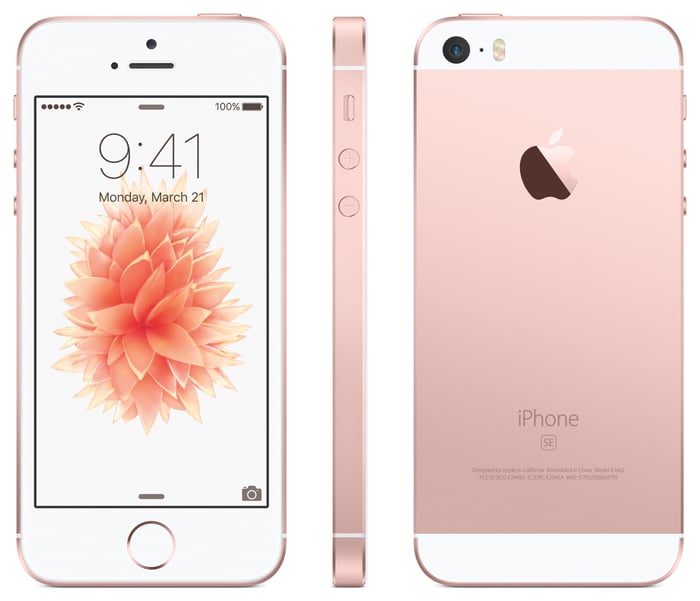Taiwanese publication Economic Daily News (via MacRumors) says that Apple (AAPL 1.97%) intends to refresh its low-cost, small-screen iPhone, known as the iPhone SE, during the first half of 2018.
The refreshed product is intended to allow Apple to continue to compete in regions where consumers are cost-sensitive and can't afford its ultra-expensive flagship devices.

Image source: Apple.
Let's go over what Apple needs to deliver with this product to make it a compelling upgrade to the current model.
More modern design and display
The iPhone SE uses the same basic display and casing that were introduced with the iPhone 5 in 2012. If Apple is serious about taking market segment share in more cost-sensitive markets -- markets where competing device vendors regularly offer devices with high-end specifications and reasonably modern designs -- it needs to make sure that its next iPhone SE is spruced up in these areas.
Indian publication Tekz24, claimed that next year's iPhone SE will have "slightly thinner side bezels" than those on the current iPhone SE, which should improve the screen-to-body ratio of the device, ultimately making it more appealing to customers.
It's not clear whether Apple will fill the space saved by the bezel reduction with more screen or simply shrink the physical footprint of the device, but either one would be a welcome change.
Additionally, the display technology in the iPhone SE is old. It's reasonably sharp, being a retina display with a pixel density of 326 pixels per inch, but in terms of image quality, it needs a boost. Per testing performed by NotebookCheck.net, the display on the iPhone SE is accurate and bright, but it has a poor contrast ratio of just 685:1 (when it comes to contrast ratio, higher ratios generally result in better image quality).
The iPhone 6s, in the website's testing, delivered a contrast ratio of 1415:1.
Apple doesn't need to go nuts in upgrading the iPhone SE's display (it's probably safe to leave out features such as its True Tone display technology as well as support for wide color), but at this point, the company needs to offer something better than a display that was state of the art in 2012.
Upgraded internals
One of the big selling points of the iPhone SE when it launched in early 2016 was that it included thoroughly modern internal specifications. It used Apple's then-revolutionary A9 applications processor, included 2GB of fast memory, and even used the same rear-facing camera that the iPhone 6s had.
The phone was really fast in its heyday and is still quite a zippy device today, as the A9 processor still handily outperforms low-end and mid-range Android processors in key areas, like CPU performance.

Image source: Apple.
However, newer processors are faster, more efficient, and help to improve the user experience in key areas like photo and video capture quality.
Indian publication Tekz24 claims that the upgraded iPhone SE will feature an A10 Fusion chip (improvement from the iPhone SE), 2GB of memory (same as the iPhone SE), a 12-megapixel rear camera (same as the iPhone SE, though this may be the upgraded 12-megapixel sensor from the iPhone 7), and a 5-megapixel front-facing camera (a big upgrade from the 1.2-megapixel sensor on the today's iPhone SE).
Oh, and for good measure, the battery in the next iPhone SE is reportedly going to be a bit larger than the one in today's iPhone SE.
If these specs are accurate, then I think Apple will be competing from a position of strength in terms of the kind of performance that it delivers for the price with the next iPhone SE, just as it has been with the iPhone SE.
One more thing to consider
In addition to the improvements mentioned above, I think Apple will also include a faster LTE modem in the next iPhone SE compared to the one found in the current-generation model.
The current iPhone SE includes the same LTE modem that was found inside of the iPhone 6 -- the Qualcomm (QCOM 3.06%) MDM9625. This modem is far behind the times in terms of transmission speeds -- it supports 150 megabits per second download and just 50 megabits per second download speeds.
This year's iPhone 8/8+/X have modems that support 600 megabits per second download and 150 megabits per second upload speeds, and the flagship iPhones that'll be released next fall are expected to support download speeds of about 1 gigabit (1000 megabits) per second.
An upgrade to a newer cellular modem would not only help improve cellular performance, but it could lead to an improvement in power efficiency, ultimately boosting battery life.
For this device, I think it'd make sense to use something like Qualcomm's MDM9645 (also known as the Snapdragon X12 modem), as it would give this new iPhone SE roughly same cellular capabilities as today's iPhone 8/8+/X phones.





